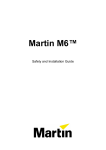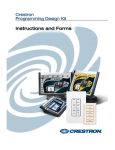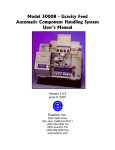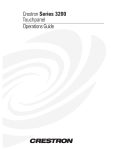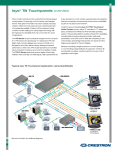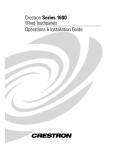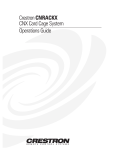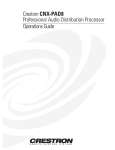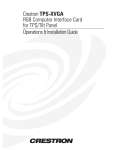Download Crestron CT-3000 Specifications
Transcript
CRESTRON Contents Series 3000 Touchpanels 1 Description .......................................................................................................................... 1 Functional Description ........................................................................................... 1 Physical Description............................................................................................... 3 Configuration Differences ...................................................................................... 5 Leading Specifications ......................................................................................................... 6 Installation/Setup ................................................................................................................. 7 Identity Code.......................................................................................................... 7 Recommended Cleaning......................................................................................... 7 Preparation for Use................................................................................................. 7 Hardware Hookup................................................................................................... 8 Configuring the Touchpanel................................................................................... 9 Programming ..................................................................................................................... 15 Reserved Join Numbers ........................................................................................ 15 Workshop Versus SIMPL Windows...................................................................... 15 Problem Solving................................................................................................................. 19 Troubleshooting ................................................................................................... 19 Further Inquiries .................................................................................................. 20 Syntax .................................................................................................................. 20 Return and Warranty Policies............................................................................................. 21 Merchandise Returns / Repair Service .................................................................. 21 CRESTRON Limited Warranty ............................................................................ 21 Operations Guide - DOC. 8094B Contents • i CRESTRON Series 3000 Touchpanels Description Functional Description The Series 3000 Touchpanels are 9.6 inch (23.9 cm) passive matrix touchscreen control panels for the CRESNET II remote control system (herein referred to as the CRESNET II system). There are 12 Series 3000 configurations available. Six of the 12 touchpanels offer 256 color display and are commonly known as ColorTouch. The remaining six touchpanels offer 256 shades of grayscale display and are commonly known as BriteTouch. ColorTouch and BriteTouch are available in lectern-mount and adjustable tiltcase configurations. Configuration selection is based on application requirements. Refer to “Configuration Differences” on page 5 for a more detailed description of each. The purpose of a ColorTouch and BriteTouch Series 3000 unit is to replace hardwired panels in either a CRESNET II or an RS-232 based control system. The touchpanel is capable of replacing large, complicated panels with a series of simpler screens, each specific to the control problem at hand. Thus, very large numbers of functions can be made available to the user without the confusion associated with hardware panels of that complexity. Series 3000's icons, graphics, and text can dramatically increase any user's comprehension of the control environment. Devices, functions, and control zones are quickly organized and more easily accessed. The Series 3000 Touchpanels offer: Operations Guide - DOC. 8094B • 256 color display (for ColorTouch only) • 256 shades of grayscale display (for BriteTouch only) • pop-up sub panels to reduce memory requirements, providing optimal speed and performance • multiple button, slider control, and icon configurations • up to 999 functions and 96 screens • imported photographs, drawings, and icons • support for downloadable fonts - proportional and non-proportional • foreign language text Series 3000 Touchpanels • 1 CRESTRON • RS-232 interface for stand-alone applications (lectern-mount configurations only) • optional feature buttons adjacent to touchpanel • printout of screen designs on standard printer • Position Lock feature provides durable support of panel at any angle of inclination between 0 and 70 degrees (tiltcase configurations only). Software Have a comment about Crestron’s software? Direct software related suggestions and/or complaints to Crestron via email ([email protected]). Do not forward any queries to this address. Instead refer to “Further Inquiries” on page 20 for assistance. VisionTools™ for Windows (VTW), a design and programming Windows™-based software, permits the creation of unlimited control screen variations incorporating two and three-dimensional graphics and text. A set of pages which make up a project can be designed for each Series 3000 Touchpanel application. Each page contains objects such as custom control graphics, two and three-dimensional buttons, sliders, and digital readouts which allow the user to interface with the CRESNET II system. The project is uploaded to the touchpanel and programmed into the flash PROM. The touchpanel uses the programmed project until another set is uploaded from the PC. The PC may be disconnected from the rack or panel except during reprogramming. For additional software information, consult the help file available on the VTW installation disks. Position Lock Button The position lock button is centrally located at the front of the base on Series 3000 adjustable tiltcase touchpanels. These touchpanels permit incremental angle positions indicated by audible clicks. Range of motion is adjustable for user comfort and can vary from zero inclination to 70 degrees from horizontal. Thus the user can position the touchscreen to a comfortable angle, just as a microphone can be repositioned for each speaker. The comfortable angle is herein referred to as user position. The position lock guarantees that once a user position is established or locked, the angle will not degrade from repeated presses on the touchscreen. The touchscreen is free to move up from the horizontal to an incremental angle. Grasp the touchscreen with a hand at each side and gently tilt up to a comfortable position. To activate position lock, slightly reverse the motion until the touchpanel stops moving. Correct hand placement is shown below. The touchscreen is now set into user position. Hand Position for Tilting Touchpanel to Vertical Once in user position, position lock is activated which means the touchscreen can not be forced to the horizontal position without depressing the position lock button. The touchscreen is still free to tilt up; a new user position is established at each increment or audible click. 2 • Series 3000 Touchpanels Operations Guide - DOC. 8094B CRESTRON The position lock button needs to be depressed before the touchscreen can be returned to the horizontal position. To depress the button, slightly position the touchscreen in the vertical direction with two hands, avoiding any tilting. The position lock button can be depressed with one hand; the touchscreen can be tilted down to the horizontal position with the other, shown below. Hand Position for Tilting Touchpanel to Horizontal Feature Buttons ColorTouch and BriteTouch configurations with the letter “B” in their suffix have seven feature buttons located to the left of the touchpanel screen. The buttons are identified with numbers one through seven from top to bottom. These buttons are hard-coded join numbers that serve as “hot keys” for repetitive functions. For example, assign a feature button’s join number to a frequently used subpage. Create the subpage on every page of the project. Thus, the subpage can be recalled with the touch of a single button regardless of the current page being displayed. Physical Description Touchpanels The 9.6 inch (23.9 cm) touch sensitive viewing screen is located on the front of each Series 3000 Touchpanel. The electronic hardware is housed in a high impact, black molded plastic enclosure for the adjustable tiltcase configurations, shown after this paragraph. These touchpanels are designed to be placed on a counter and possess a hinged base which can tilt from 0 to 70 degrees. Depress the button located at the front of the base when pivoting the touchpanel to the horizontal position. A 6-pin, 6-position RJ11 modular jack is located at the rear of the adjustable tiltcase base. Use the cable assembly (supplied) to connect the touchpanel to the CN-RJ11 (supplied), which attaches directly to the CRESNET II network. Aside from display color, the only difference between the six tiltcase touchpanels is that configurations with the letter “B” in their suffix have seven feature buttons on the front panel adjacent to the touchscreen. The buttons are used as “hot keys” for repetitive functions. Also, the “/1M” suffix indicates a memory upgrade available on two of the six tiltcase panels. Operations Guide - DOC. 8094B Series 3000 Touchpanels • 3 CRESTRON Physical Views of Tiltcase Series 3000 Touchpanels (CN-RJ11 not shown) The lectern mount configurations, shown below, are denoted with the letter “L” in their suffix. They are housed in a black metal box topped with a plastic cover. The four-pin network and nine-pin RS-232 connector ports are located on the rear of the panel. Aside from display color, the only difference between the six lectern mount touchpanels is that configurations with the letter “B” in their suffix have seven feature buttons on the front panel adjacent to the touchscreen. Also, the “/1M” suffix indicates a memory upgrade available on two of the six lectern panels. Physical Views of Lectern Series 3000 Touchpanels Interface Module: CN-RJ11 NOTE: All tiltcase Series 3000 touchpanels are supplied with a cable assembly that connects to the CN-RJ11 (supplied). Pinout information is provided in this section of the Operations Guide. If the assembly must be mutilated in any way, Crestron cannot guarantee the behavior of the touchpanel. The product may not function accordingly, as stated in this Operations Guide. CRESTRON’s CN-RJ11 is a network one-to-one converter that interfaces 4-wire CRESNET and modular devices. The converter is housed in a black enclosure with silk-screened top panel, shown after this paragraph. A 4-pin network connector is located on one side of the unit. A 6-position, RJ11 modular telephone jack is located on the opposite side. At the shorter sides of the CN-RJ11, the enclosure extends to form feet at a right angle to the side. There are three holes per foot for inserting screws to further stabilize the unit. 4 • Series 3000 Touchpanels Operations Guide - DOC. 8094B CRESTRON Physical Views of the CN-RJ11 TOP VIEW SIDE VIEW (RJ11 CONNECTOR) SIDE VIEW (4-PIN CONNECTOR) 6-Pin Jack Pinout (for CN-RJ11) PIN # SIGNAL COLOR 1 +24 V (Network) WHT 2 3 +24 V (Network) Y (Data) BLK RED 4 5 6 Z (Data) GND (Network) GND (Network) GRN YEL BLU #1 TAB (VISIBLE, ON TOP) Configuration Differences There are 12 Series 3000 configurations available and selection depends on color versus grayscale display, type of installation (tiltcase or lectern mount) and whether physical buttons for repetitive functions are desired. A configuration is defined by one of two prefixes, CT- or LC-, and one of six suffixes, no suffix, B, BL, L, /1M, and L/1M. The CT- or LC- prefix identifies the touchpanel as having either a 256 color display or a 256 grayscale display, respectively. No suffix indicates an adjustable tiltcase configuration; these units are moveable and can tilt. The “B” suffix identifies the touchpanel as having feature buttons. The "L" suffix identifies the touchpanel as a lectern mount. The “/1M” suffix identifies the touchpanel as having its memory upgraded to 1 Mbyte. Refer to the table below for a concise listing of each Series 3000 configuration. Series 3000 Touchpanel Configurations CONFIGURATION Operations Guide - DOC. 8094B DISPLAY INSTALLATION FEATURE MEMORY BUTTONS CT-3000 256 Color Movable and can tilt None 256 Kbytes CT-3000/1M CT-3000B 256 Color 256 Color Movable and can tilt Movable and can tilt None Seven 1 Mbyte 256 Kbytes CT-3000L CT-3000L/1M 256 Color 256 Color Lectern mount Lectern mount None None 256 Kbytes 1 Mbyte CT-3000BL LC-3000 256 Color 256 Grayscale Lectern mount Movable and can tilt Seven None 256 Kbytes 256 Kbytes LC-3000/1M LC-3000B 256 Grayscale 256 Grayscale Movable and can tilt Movable and can tilt None Seven 1 Mbyte 256 Kbytes LC-3000L LC-3000L/1M 256 Grayscale 256 Grayscale Lectern mount Lectern mount None None 256 Kbytes 1 Mbyte LC-3000BL 256 Grayscale Lectern mount Seven 256 Kbytes Series 3000 Touchpanels • 5 CRESTRON Leading Specifications The table below provides a summary of leading specifications for the Series 3000 Touchpanels. Dimensions and weight are approximations rounded to the nearest tenth unit. Leading Specifications for Series 3000 Touchpanels SPECIFICATION DETAILS Power Requirements 12 Watts, 24 VDC 0.5 Amp CRESNET Power Factor 12 Watts Version 4.20.03 or later CRESNET II Workshop CRESNET II Operating System VisionTools for Windows SIMPL Windows Memory 3.11.18 or later Version VTW 10.7.1 or later Version 1.0 or later 256 Kbytes flash memory for CT-3000, CT-3000B, CT-3000L, CT-3000BL, LC-3000, LC-3000B, LC-3000L, & LC-3000BL 1 Mbyte flash memory for CT-3000/1M, CT-3000L/1M, LC-3000/1M, & LC-3000L/1M CT-3000, CT-3000B, CT-3000/1M, LC-3000, LC-3000B, & LC-3000/1M Dimensions & Weight (without CN-RJ11) CN-RJ11 Dimensions & Weight CT-3000L, CT-3000BL, CT-3000L/1M, LC-3000L, LC-3000BL, & LC-3000L/1M Dimensions & Weight Height: 8.6 in (212.8 cm) Width: 11.2 in (28.5 cm) Depth: 7.0 in (17.8 cm) Weight: 5.5 lb (2.5 kg) for CT- configurations Weight: 5.3 lb (2.4 kg) for LC- configurations Height: 2.0 in (5.0 cm) Width: 3.3 in (8.3 cm) Depth: 1.2 in (3.0 cm) Weight: 0.4 lb (0.2 kg) Height: 8.3 in (21.0 cm) Width: 12.8 in (32.4 cm) Depth: 1.6 in (4.0 cm) Weight: 5.0 lb (2.3 kg) for CT- configurations Weight: 4.7 lb (2.1 kg) for LC- configurations View Screen Dimensions Height: 5.8 in (14.7 cm) Width: 7.7 in (19.6 cm) View Screen Resolution View Screen Display 640 x 480 pixels Dual-Scan Passive Matrix LCD View Screen Illumination View Screen Touch Screen Backlit Fluorescent Resistive Membrane As of the date of manufacture, the Series 3000 Touchpanels have been tested and found to comply with specifications for CE marking. 6 • Series 3000 Touchpanels Operations Guide - DOC. 8094B CRESTRON Installation/Setup Identity Code Every equipment and user interface within the CRESNET II network requires a unique identity code (ID CODE). These codes are recognized by a two-digit hexadecimal number from 03 to FE. Refer to “Configuring the Touchpanel” on page 9 for instructions on setting the unit's ID CODE. The ID CODE of the unit must match the ID CODE specified in the CRESNET II SIMPL-I program. Refer to “Programming” on page 15 for an example of SIMPL-I program. Recommended Cleaning Keep the surface of the touchscreen free of dirt, dust, or other materials that could degrade optical properties. Long term contact with abrasive materials can scratch the surface which may detrimentally affect image quality. For best cleaning results, use a clean, damp, non-abrasive cloth with any commercially available non-ammonia glass cleaner. Bezels may not provide a complete water-tight seal. Therefore, apply cleaning solution to the cloth rather than the surface of the touchscreen. Wipe touchscreen clean and avoid ingress of moisture beneath panels. Preparation for Use The only preparation that may be required is to mount the touchpanel. If a lectern mount Series 3000 touchpanel is being installed, the cutout dimensions are required. Refer to the lectern cutout details below for these configurations. Cutout measurements in the figure have been rounded up to the nearest 1/8 inch. Lectern Cutout Detail for Series 3000 Touchpanels If the tiltcase configuration is being mounted to a flat surface, locate the mounting holes on the “foot” of the touchpanel. Refer to the mounting details, shown after this paragraph. Mount the touchpanel with four #6-32 hardware (not supplied). Operations Guide - DOC. 8094B Series 3000 Touchpanels • 7 CRESTRON Mounting Detail for Tiltcase Series 3000 Touchpanel Hardware Hookup Due to configuration differences (between lectern and tiltcase models), the hookup diagram differs among Series 3000 touchpanels. Complete the following steps in the order provided to ensure proper installation of the unit. 1. Before making any connections, review latest revision of network interconnection drawing (Doc. 5411) or, if necessary, the network modular cable requirements (Doc. 5682). 2. Connect the touchpanel to the CRESNET II network via a CRESNET II network cable, shown below, and appropriate interface module. Recommended CRESNET II Network Cable, Part No. CRE-2S18218 #18 AWG Stranded Wire 2x Twisted Pairs NOTE: Wire is available from Liberty Wire & Cable (719) 260-0061. CN-RJ11 OR ANY LECTERN MOUNT CONFIGURATION • CNRACK OR CNRACK-D OR CNMS A supplied cable assembly (P/N 15717) with 6-position, 6-pin connectors on each end connects the tiltcase configuration touchpanel to the CN-RJ11. Connect the CN-RJ11 to the CRESNET II system via the network cable. Typical Connection Diagram for Tiltcase Configurations NOTE: UNITS IN THIS ILLUSTRATION ARE NOT DRAWN TO SCALE. CABLE ASSEMBLY (P/N 15717) CONNECT TO CNMS, CNRACK, OR CNRACK-D Refer to the CRESNET II Network Cable drawing in this section of the Guide. SIDE VIEW OF TILTCASE CONFIGURATION 8 • Series 3000 Touchpanels Operations Guide - DOC. 8094B CRESTRON • Connect the lectern mount configuration directly to the CRESNET II system via the network cable. Typical Connection Diagram for Lectern Mount Configuration CONNECT TO SERIAL PORT OF COMPUTER Use only for direct connection to PC to load panels without network. CONNECT TO CNMS, CNRACK, OR CNRACK-D Refer to the CRESNET II Network Cable drawing in this section of the Guide. NOTE: Network termination points are available at the control system power supply. Network units may also be daisy-chained together. Refer to the latest revision of the CRESNET II reference manual section on CNPWS power supplies (Doc. 8091) for wire gauge specifications and connection details. 3. Connect the lectern mount configuration to the serial port of the PC via the port labeled RS-232. Cable assembly is not supplied. 4. Apply power to the touchpanel and observe illumination of the touchsensitive screen. The touchpanel enters RUN MODE and displays a loaded panel page. To enter SETUP MODE and not RUN MODE, hold a finger to the touchscreen as power is applied. The user may configure the unit while in SETUP MODE. Configuring the Touchpanel To configure the unit, it may be necessary to access a series of setup screens prior to viewing run-time screens that are loaded into the touchpanel for normal operation. The Main Menu for configuring the touchpanel appears when a finger is held to the touchscreen as power is applied. Remove your finger when the message "SETUP MODE" appears on the touchscreen. Holding a finger to the touchscreen for five seconds after the "SETUP MODE" message is displayed sets the brightness to high and the contrast to a safe value. Upon entering SETUP MODE, the Main Screen, shown below, displays four buttons: TOUCH SCREEN CALIBRATION, DIAGNOSTICS, SETUP, and SAVE SETUP AND RUN PROGRAM. Main Menu Operations Guide - DOC. 8094B Series 3000 Touchpanels • 9 CRESTRON Calibration Menu Calibration of the touchscreen is required if the active touch area of a button does not coincide with the button's image. Select the TOUCH SCREEN CALIBRATION button to display the Calibration Menu, shown below. The Calibration Menu offers the choice to initiate calibration with the Perform Calibration button or return to the previous screen with the Return to Main Menu button. Choose an option by touching the correct button. When touching the screen, be as accurate as possible. If you proceed to calibrate the touchpanel, the screen prompts you with the message "Touch Screen Calibration Menu" nearly centered on the display. Another message, "Touch Upper Left Corner", appears in the upper left corner. Touch the corner of the screen to initiate calibration. Another message, "Touch Lower Right Corner", appears in the lower right corner. Touch the corner of the screen to return to the Main Menu. Calibration Menu Diagnostics Menu The DIAGNOSTICS button from the Main Menu should only be used under supervision from a CRESTRON technical support representative during telephone support. The options available from the Diagnostics Menu, shown below, are numeric in nature and their interpretation is beyond the scope of this manual. Diagnostics Menu Setup Menu To obtain the Setup Menu, shown after this paragraph, select and hold the SETUP button from the Main Menu until the Setup Menu is displayed. Many options for setting parameters of the touchpanel are available from the Setup Menu and are explained in the following paragraphs. After setup parameters have been set, select the Return button, located at the lower right corner of the Setup Menu. 10 • Series 3000 Touchpanels Operations Guide - DOC. 8094B CRESTRON Setup Menu Brightness Screen brightness may need to be altered because of ambient light conditions or personal preference. Three buttons, Brightness Low, Brightness Medium, and Brightness High, located in the bottom row of the Setup Menu may be selected to assign brightness setting. Current brightness setting is shown in light gray text . Contrast Screen contrast may need to be altered because of ambient light conditions, panel temperature, or personal preference. Two contrast buttons, Contrast << and Contrast >>, located in the two left-most columns of the middle row of the Setup Menu may be held down for continuous and smooth adjustment of the screen. Save Setup It is advisable to regularly save setup parameters if the user is satisfied with the settings. If parameters are saved, the settings are restored in the event of a power failure. The Save Setup button located just above the Return button in the corner of the Setup Menu may be selected at any time to save setup parameters. The button text changes color from black to light gray text while in save mode. Return Select the Return button, located at the lower right corner of the Setup Menu, after setup parameters have been set. Backlight Timeout Menu NOTE: Display backlight requires warm-up time. A display reaches 80% of its final level in five minutes and full brightness in 20 minutes. The touchpanel display hardware life can be lengthened by turning off the backlight when the touchpanel is inactive. The Backlight Timeout button is located in the middle row of the third column of the Setup Menu. Selection of this button changes the touchpanel display to reveal the Backlight Menu, shown below. The length of touchpanel inactivity can be specified to minimize power utilization. Backlight Menu Operations Guide - DOC. 8094B Series 3000 Touchpanels • 11 CRESTRON BACKLIGHT TIMEOUT is displayed on the Backlight Menu. This setting turns the backlight off when the touchpanel is inactive for a specified time frame (shown in minutes). When the touchpanel is activated, the last screen to be displayed reappears. A two minute BACKLIGHT TIMEOUT is shown in the illustration. Minutes can vary from 0 to 120, where 0 disables the timeout. Down and up arrow buttons decrease and increase the timeout, respectively. Although the STX POWER DOWN TIMEOUT is displayed on the Backlight Menu, its functionality is disabled for Series 3000 Touchpanels. After the timeout parameter is set, touch the SAVE TIMEOUTS button in the lower left corner of the menu to save the new settings. Touch the RETURN button, located in the bottom right corner of the screen, to display the Setup menu. Panel Tracking Panel tracking is a useful communication feature between touchpanels when more than one touchpanel exists on the network. Panel tracking is enabled when the Panel Track button, centrally located in the top row of the Setup Menu, is selected. Selection is indicated with light gray text. When enabled, a given touchpanel maintains communication in such a way that a page change to any touchpanel on the network forces the same page change to all enabled touchpanels. Panel tracking is disabled when the Panel Track button is deselected. When disabled a given touchpanel does not respond to page changes made to other touchpanels on the network. Panel tracking is factory set with the Panel Track button deselected. Interface Menu The touchpanel communicates with a CRESNET II system to activate other controls or to display feedback from components within the system. The communication interface must be correctly specified or communication will not occur. To set communication parameters select the Interface button located in the upper left corner of the Setup Menu and display the Interface Menu, shown below. Interface Menu The CRESNET network identity number (NET ID) is displayed in the upper-most rectangle of the Interface Menu. NET ID is the two-digit hexadecimal number represented by ## in the figure for illustrative purposes. The hexadecimal number can range from 03 to FE and must correspond to the NET ID set in the SIMPL-I program of the CRESNET II system. Matching NET IDs between touchpanel and VisionTools for Windows program is required if data is to be successfully transferred or new touchpanel screens are to be loaded. NET ID is factory set to 03. Two side-by-side buttons beneath the hexadecimal display, < Cresnet ID and Cresnet ID >, decrease and increase the NET ID by one, respectively. The touchpanel usually communicates with a CRESNET II system. Occasionally the touchpanel can be used in a local demo mode where it merely displays various menus, but does not communicate with CRESNET II system. In local mode, the 12 • Series 3000 Touchpanels Operations Guide - DOC. 8094B CRESTRON directory buttons change pages, but buttons requiring feedback do not work. Two centrally located buttons on the Interface Menu, Local and Cresnet II, determine communication mode. Select Local to set the touchpanel into demo mode and Cresnet II for normal CRESNET II communication mode. Text within the selected button changes color from black to light gray text. Communication mode is factory set to Cresnet II. Two side-by-side buttons, RS-232 On and RS-232 Off, are located just above the Return to Previous Menu button at the bottom of the Interface Menu. RS-232 is just for external control applications. Panel loading is always available; RS-232 does not have to be on. If the touchpanel is utilized in a system without a CRESNET II system, ensure that the RS-232 button is selected. Additional RS-232 parameters must be set with the RS-232 Menu since alternative parameters may be required for successful transfers to a PC. Text within the selected button changes color from black to light gray text. RS-232 On is the default setting. Select the Return to Previous Menu button, located at the bottom of the Interface Menu, after interface parameters have been set. RS-232 Menu (Lectern-Mount Configurations Only) Select the RS-232 button, located at the top of the second column of the Setup Menu, to change the touchpanel display to the RS-232 Menu, shown below. The RS-232 Menu specifies four parameters required for the touchpanel to use its RS232 serial port. Ten baud rate buttons, labeled 110, 150, 300, 600, 1200, 2400, 4800, 9600, 19200, and 38400, are available for selection. Also, select seven or eight data bits; none, odd, or even parity; one or two stop bits. RS-232 Menu RTS/CTS handshaking is supported by the Series 3000 Touchpanels. If handshaking is desired, select the RTS/CTS button. If no hardware handshaking is needed, select the Off button. Selections for all RS-232 parameters are indicated with light gray text. The parameters are factory set to 38.4 Kbd, eight data bits, no parity bits, and one stop bit. Handware handshaking is factory set to Off. Select the Save and Return button, located at the bottom of the RS-232 Menu, after RS-232 parameters have been set. RS-232 Protocol Series 3000 Touchpanels support panel operation via a host computer through the RS-232 port. Crestron recommends that the following serial data format is set. Suggested Serial Data Format Baud Rate: 38400 Data Bits: 8 Parity: None Stop Bits: 1 These settings may be altered via the RS-232 Menu when configuring the touchpanel, however, doing so may prevent Crestron supplied software from Operations Guide - DOC. 8094B Series 3000 Touchpanels • 13 CRESTRON operating with the touchpanel. Low baud rates will cause the panel to appear unresponsive. For example, at 300 baud, a single button press (and release) generates 12 characters and requires more than 0.333 of a second to send. Delays as short as 0.1 of a second are generally considered perceptible and somewhat annoying. Command Format - Command format for all items sent to or from the touchpanel is very simple. All items are ASCII strings terminated by a <cr>. Line feed characters are ignored, thus <cr><lf> or <lf><cr> are also acceptable line terminators. When the touchpanel sends a line, it is always terminated with <cr><lf>. For all strings, the first character determines command type. Numeric arguments, if present, are in decimal and separated by commas. No control characters are embedded in the strings to ease processing the strings with high level languages. Be careful when using commas in BASIC, because BASIC uses commas for field separators when reading strings from a file using the INPUT # statement. Since we are dealing with complete lines, use the LINE INPUT # statement to cure this problem. P<#> and R<#> Commands - When in RUN mode, pressing a button (assuming that it has been joined) generates a six-character code in the format P###<cr><lf>, where ### is a three-character decimal number in the range of 1 through 999, providing for up to 999 functions. When the button is released, a similar code is generated, with an 'R' in place of the 'P'. Given that only one button may be pressed at a time, an 'R' code always follows a 'P' code. A fixed three-digit format is used to simplify software on the host. Codes may be sent to the touchpanel in the same form as they are received. The 'P' form turns on a function and the 'R' form turns off a function; sending back information received from the touchpanel (i.e., jumping pins 2 and 3) makes the buttons momentary. Notice that the touchpanel responds to P and R commands even when configured for other interface modes. Selecting an RS-232 interface mode merely enables P and R commands to be issued. In addition, the fixed format is not required for commands sent to the touchpanel; P1, P01, and P001 are all perfectly valid commands. Compared to running on CRESNET II, an RS-232 interface to a personal computer is slower, provides less features (such as tracking, among others), is less noise immune (CRESNET uses balanced transmission for high common mode rejection, RS-232 does not), and requires the user to supply the control logic program in the PC. V<chan>,<level> Command - Levels in gauge and slider objects may be set through the RS-232 port. The command contains both the object channel number (1-255) and level (0-65535) in decimal separated by a comma. For example, V6,32768 would set channel 6 to level 128, or half way up. One quick note on baud rate and smooth ramping. Ramping is accomplished by sending successive levels to the object. To do this in 64 levels over three seconds, for example, requires about 576 bytes worth of commands to be sent, and could not be accomplished at any rate less than 2400 baud. Obviously, ramping several objects at once requires a baud rate several times as high. Indirect Text - Series 3000 Touchpanels support a feature that permits the text field in any user-defined button to be altered on the fly in RUN mode. This is accomplished by substituting a text pointer for the text in the button. The text pointer informs the panel to use the contents of a variable that may be dynamically redefined as the text field for the button. This presents a considerable advantage over other methods in that changing screens does not destroy information and that information may be placed in buttons not currently displayed. 14 • Series 3000 Touchpanels Operations Guide - DOC. 8094B CRESTRON The text pointer is a single letter, ‘A’ through ‘Z’ or ‘a’ through ‘z’ preceded by the “at” symbol (@). If [text…] is omitted, the text field is cleared. If [text…] exists, it is added to the text field. For example, consider the following string : @CNow is the time<cr> @Cfor all good men<cr> @Cto come to the<cr> @Caid of the party.<cr> Assuming that a button with an @C text pointer was being displayed, the contents of the button would be changed to: Now is the time for all good men to come to the aid of the party. NOTE: To clear the text field for this example, type in “@C<cr>”. As each line is entered, the display is updated. Since the text may be placed in several different buttons, no boundary checking is done to see if the text fits in the button. If the text overflows the boundaries, it remains centered about the center of the button. Save Setup and Run Program The Save Setup and Run Program button, located at the upper right corner of the Main Menu, saves all of the setup information to EEPROM and displays the main page that has been programmed into your system. Programming Reserved Join Numbers A reserved join number is a feature of the software that enables a designer to create a button on a page that either calls up the Setup Menu, selects brightness, etc. The table below provides a list of reserved join numbers available within the software. Reserved Join Numbers for Series 3000 Touchpanels JOIN NUMBER FUNCTION VALUE 1016 Brightness Off 1017 1018 Brightness Brightness Low Medium 1019 1023 Brightness Contrast High Up 1024 1035 Contrast Call up Setup Menu Down Not Applicable Workshop Versus SIMPL Windows The print date of this Operations Guide occurs so precariously close to the official release of SIMPL Windows that an exemplary discussion of both programming methods should coexist. The Workshop is Crestron’s DOS-based programming Operations Guide - DOC. 8094B Series 3000 Touchpanels • 15 CRESTRON software; whereas SIMPL Windows, by virtue of its name, is Windows-based. Although Crestron will continue to provide support for Workshop queries, there is no plan to add new features to it. For this reason, Crestron suggests that all new programming be done with SIMPL Windows. Workshop SIMPL is CRESTRON's programming language designated for easy implementation of the control system requirements. The objects that are used in SIMPL are called symbols. A basic touchpanel SIMPL program is shown below in block diagram form. Series 3000 SIMPL Program The CRESNET II Workshop is designed to simplify the various operations needed to program and run a CRESNET II control system. The series of screen displays, shown below, are accessible from the "Define Network" option of the SIMPL-I Menu in the CRESNET II Workshop.These screens are shown to clarify the means of assigning signal names for the SIMPL program in the previous illustration. Workshop Screens (1 of 2) Workshop Screens (2 of 2) 16 • Series 3000 Touchpanels Operations Guide - DOC. 8094B CRESTRON SIMPL Windows SIMPL Windows was designed to supersede the CRESNET II Workshop. It provides a well-designed graphical environment with a number of workspaces (i.e., windows) in which a programmer can select, configure, program, test, and monitor a CRESNET control system. NOTE: The following description assumes that the reader has some knowledge of SIMPL Windows. If not, please refer to the extensive help information provided with the software. Using the same example in the previous Workshop section, the following paragraphs and illustrations provide insight to a small portion of a CRESNET control system developed with SIMPL Windows. To begin, the programmer should envision the system in block diagram form, shown below. Block Diagram of CRESNET Control System Use the Configuration Manager workspace in SIMPL Windows to select and configure all the devices that need to be included into the system. For this example, a CT-3000 must be added to the system and its NET ID must be set to 11, shown below. Graphical System View in SIMPL Windows’ Configuration Manager Use the Programming Manager workspace in SIMPL Windows to select symbols and assign their respective signals. For this example, a touchpanel symbol was added automatically when the CT-3000 was added to the system. Assign signals as shown after this paragraph. Operations Guide - DOC. 8094B Series 3000 Touchpanels • 17 CRESTRON Graphical Detail View of a Touchpanel in SIMPL Windows’ Programming Manager For this overly simplified example, there is only one logic symbol used. Use the Programming Manager to select and assign signals to the Interlock symbol, shown below. Graphical Detail View of an Interlock in SIMPL Windows’ Programming Manager The signals from the Interlock are used as feedback into the touchpanel as well as to drive the relay card that resides in the first slot of the CNMS. Use the Programming Manager to select and assign signals to the Relay card symbol, shown below. Graphical Detail View of the Relay Card in SIMPL Windows’ Programming Manager 18 • Series 3000 Touchpanels Operations Guide - DOC. 8094B CRESTRON Problem Solving Troubleshooting The table below provides corrective action for possible trouble situations. If further assistance is required, please contact a CRESTRON technical support representative. Series 3000 Troubleshooting TROUBLE POSSIBLE CAUSE(S) CORRECTIVE ACTION Use Performance Viewport (via CRESNET Touchpanel Touchpanel is not communicating to the Workshop or VTW) to poll the network. Verify does not network connection to the touchpanel. network. function. Verify touchpanel is in "CRESNET II" mode as defined in the Interface Menu of the "Configuring the Touchpanel". Touchpanel is not Confirm that power is supplied to the network. receiving network power. Touchpanel is Enter SETUP MODE and recalibrate. incorrectly calibrated. Touchpanel Incorrect network Touch screen to remove message and verify is not wiring. correct wiring to all connectors. responding Touchpanel ID is not Touch screen to remove message and enter and screen set to match the NET Performance Viewport (via CRESNET displays ID in the SIMPL Workshop or VTW) to poll the network. Verify "Network program. that the NET ID for the touchpanel is properly Poll Error" set to match the SIMPL program. message. Touchpanel ID not Enter Performance Viewport (via CRESNET unique, two or more Workshop or VTW) to poll the network. Verify units share same ID. that each ID is used once. Touchpanel Backlight timeout has Touch screen to reactivate. display is elapsed. dark. Screen brightness is Enter SETUP MODE and alter screen improperly set. brightness from the Setup Menu. Unexpected Touchpanel is Enter SETUP MODE and recalibrate. response incorrectly calibrated. from touchpanel. Operations Guide - DOC. 8094B Series 3000 Touchpanels • 19 CRESTRON Further Inquiries If after reviewing this Operations Guide for the Series 3000 Touchpanels, you cannot locate specific information or have questions, please take advantage of Crestron's award winning technical support team by calling: • In the US and Canada, call Crestron’s corporate headquarterrs at 1888-CRESTRON [1-888-273-7876] or 1-201-767-3400. • In Europe, call Crestron International at +32.15.730.974. • In Asia, call Crestron Asia at +852.2341.2016. • In Latin America, call +525.574.15.90. For local support from exclusive Crestron factory-trained personnel call: • In Australia, call Soundcorp at +613.941.61066. • In New Zealand, call Amber Technologies at +649.410.8382. Syntax The following syntax codes are provided for compatibility purposes only. It is a sample of SIMPL-C programming for the block diagram example illustrated in “Programming” on page 15. NET.ID <03 to FE>: CTP-3000 i1 o1 “ i4 o4 20 • Series 3000 Touchpanels = <relay1> = <relay1_fb> = “ “ = <relay4> =<relay4_fb> \i1 refers to join# of touchpanel button Operations Guide - DOC. 8094B CRESTRON Return and Warranty Policies Merchandise Returns / Repair Service 1. No merchandise may be returned for credit, exchange, or service without prior authorization from CRESTRON. To obtain warranty service for CRESTRON products, contact the factory and request an RMA (Return Merchandise Authorization) number. Enclose a note specifying the nature of the problem, name and phone number of contact person, RMA number, and return address. 2. Products may be returned for credit, exchange, or service with a CRESTRON Return Merchandise Authorization (RMA) number. Authorized returns must be shipped freight prepaid to CRESTRON, Cresskill, N.J., or its authorized subsidiaries, with RMA number clearly marked on the outside of all cartons. Shipments arriving freight collect or without an RMA number shall be subject to refusal. CRESTRON reserves the right in its sole and absolute discretion to charge a 15% restocking fee, plus shipping costs, on any products returned with an RMA. 3. Return freight charges following repair of items under warranty shall be paid by CRESTRON, shipping by standard ground carrier. In the event repairs are found to be non-warranty, return freight costs shall be paid by the purchaser. CRESTRON Limited Warranty CRESTRON ELECTRONICS, Inc. warrants its Cresnet II products, denoted by a "CN" prefix model number, to be free from manufacturing defects in materials and workmanship for a period of three (3) years from the date of shipment to purchaser. Disk drives and any other moving or rotating mechanical parts are covered for a period of one (1) year. CRESTRON warrants all its other products for a period of one year from the defects mentioned above, excluding touchscreen display components which are covered for 90 days. Incandescent lamps are completely excluded from Crestron's Limited Warranty. CRESTRON shall, at its option, repair or replace any product found defective without charge for parts or labor. Repaired or replaced equipment and parts supplied under this warranty shall be covered only by the unexpired portion of the warranty. CRESTRON shall not be liable to honor warranty terms if the product has been used in any application other than that for which it was intended, or if it has been subjected to misuse, accidental damage, modification, or improper installation procedures. Furthermore, this warranty does not cover any product that has had the serial number altered, defaced, or removed. This warranty shall be the sole and exclusive remedy to the purchaser. In no event shall CRESTRON be liable for incidental or consequential damages of any kind (property or economic damages inclusive) arising from the sale or use of this equipment. CRESTRON makes no other warranties nor authorizes any other party to offer any warranty, expressed or implied, including warranties of merchantability for this product. This warranty statement supersedes all previous warranties. Operations Guide - DOC. 8094B Series 3000 Touchpanels • 21



























